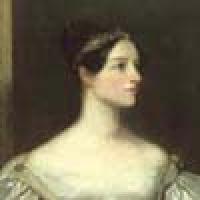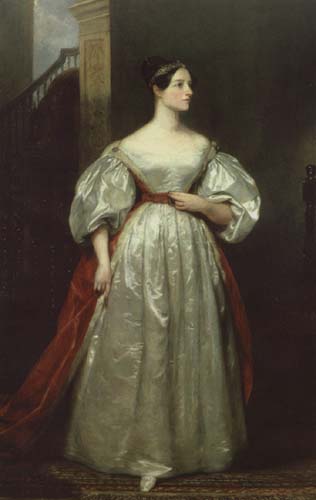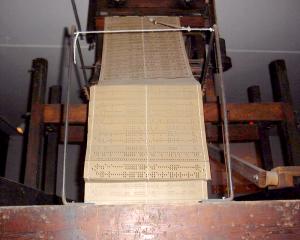
Ada Lovelace - visions of today
You are reading this article today thanks to computers. You could be anywhere in the world reading it on a web browser, the words and images transmitted almost instantaneously across the internet over thousands of kilometres.
Computers play an enormous role in my life, both at work and in the rest of my life. I work as the news editor and computer officer of Plus, a magazine published entirely on the internet. I manage my bank accounts on the internet and get money out of ATMs. I recently went to see the movie "The Incredibles", a movie entirely animated on computers. On the weekend I am going to hear some DJs who will use laptops set up alongside their decks. And I keep in touch with my family and friends back in Australia with email and digital photos.
Computers have had a massive influence our lives over the last 60 years, but they were actually first invented nearly 200 years ago. And one of the pioneers was a female mathematician called Ada Lovelace, who created one of the first computer programs and understood something of the enormous potential of computers.

Ada Lovelace, aged about 19
Lovelace was born 200 years ago, on December 10th, 1815, to an unconventional family. Her father was the famous English poet, Lord Byron, who was described by one of his lovers as "mad, bad and dangerous to know". But only a month after her birth her parents separated (due to Byron's scandalous affair with his half-sister), and Lord Byron went abroad never to see his daughter again.
Lovelace's mother, Anne Isabelle Milbanke, was also a very unusual person. She had a passion for mathematics which lead her ex-husband to once call her "the Princess of Parallelograms". So she ensured that her daughter had an excellent education in all subjects, and particularly in mathematics. Just as it was rare at the time for a woman like Milbanke to have an interest in mathematics, it was very unusual for her to provide such a good education, particularly a scientific one, for her daughter. At the time women weren't allowed to go to university or join learned societies, they couldn't vote and married women couldn't even own property. But, like her mother, Lovelace excelled in mathematics, and was encouraged by another female mathematician, Mary Somerville. And when, at the age of 17, she met Charles Babbage, she found the area of work in which would make her mark on history.
Although there were no computers as we now know them in the early 1800s, a different sort of "computer" was already in existence. This was a person whose job was to perform long and arduous calculations to find the values of logarithms and trig functions, calculations we now perform with electronic calculators. These human computers produced sets of mathematical tables for use by astronomers and navigators among others, but, unsurprisingly considering the difficulty of the calculations, these tables were known to contain many errors and mistakes. So Charles Babbage decided to create a machine, called the difference engine, to perform these set calculations automatically.
This was the age of steam, with electricity no more than the subject of early experiments, so the difference engine was envisaged as a mechanical machine, with brass cogs and moving pistons, to be powered by turning a crank or by steam.
During the construction of the first prototype, Babbage began to think about an even more advanced machine - the analytical engine - that would be able to store data and perform sequences of instructions defined on punch cards and fed into the machine, like the Jacquard looms of the time. This would mean that the analytical engine could be programmed to perform any type of calculation and be a direct forerunner of the computers we use today.

Technical drawings of part of the Mill of the analytical engine, made by Babbage's son in 1888
Lovelace saw the prototype difference engine and was fascinated by it, and by the possibilities of the plans for Babbage's analytical engine. She began to correspond with Babbage and became an expert on the engines. But she held back from publishing her own work on the subject, instead offering to translate an Italian scientist's report on one of Babbage's lectures. Women at the time faced great difficulty working and publishing in science, and, when Babbage, aware of her knowledge, asked "why she had not herself written an original paper on a subject with which she was so intimately acquainted", Lovelace modestly replied that the thought had not occurred to her.
Babbage and Lovelace agreed she should add her own notes to the translation and this addition ending up being three times the length of the original work. Her Translation and extended notes (published in 1843) became the most important work describing the analytical engine and how it could be used. Most famously, the "Notes" contained the first published computer program - instructions on how to calculate the Bernoulli numbers. It doesn't look much like what we now think of as computer code, but when punched into the instructions cards it wouldn't look that different from computer instructions on the punch cards used up until the 1970s.

Jacquard loom with punch cards ca. 1840 from Smithsonian NMAH, photo by Steven E. Schoenherr
Not only was Lovelace a pioneer of programming, but she saw beyond Babbage's vision for calculation to other potential uses for the analytical engine. She saw that the instructions and data need not represent numbers and numerical operations, but could also represent letters, images or music - a vision of modern computers and software over a century before they came into existence.
Perhaps the most amazing thing about Lovelace's work was that her program for finding Bernoulli numbers, and her thoughts about the way the analytical engine and its descendants might one day be used to create music or images, were all about machines not yet built. In fact, despite all the brilliant ideas, the analytical engine was never constructed because artisans of the time lacked the expertise to make the necessary complicated mechanical parts.
The only part of the machine to become reality was the part called the mill, which, like a modern computer's CPU, carried out the numerical operations. Babbage's son built it and used it to calculate up to 44 multiples of pi to 29 figures.
Sadly, Lovelace's health deteriorated following the publication of the "Notes". Many have felt that this was in part because she lacked a new mathematical project, although she herself felt that other publications would follow. Her friendship with Babbage continued and they tried at one point to calculate a surefire way to win at the horse races. But Lovelace's health and work deteriorated and she died of cancer in 1852, aged just 36.
It wasn't until programmable computers were first built in the 1940s that Lovelace's and Babbage's vision came to reality. In the 1970s, when the US Department of Defense decided to create a standardised computer language to use for its applications, they named it ADA in Lovelace's honour. The ADA language is still in use in critical systems such as air traffic control, in planes such as the Boeing 777, in rail transport including the TGV in France, the New York subway and London's tube, and in space missions such as Mars Express and the Beagle 2.
Although Lovelace never lived to see her programs and her visions of computer music and graphics come to life, we enjoy the benefits of these technologies every day. And it is amazing to think that this woman, who foresaw something of the amazing potential for computers and the immense impact they would have on our lives, never got to see one in real life and worked with one only in her imagination. Ada Lovelace, mathematician and computer pioneer, understood their potential over a century before the computer revolution began.
Comments
Anonymous
I very much enjoyed this article but did want to point out that the Ada programming language is written as 'Ada' and not 'ADA'.
Anonymous
maybe because ADA stands for something
Anonymous
great article. my friends name is ada she would love to read this. thi really helped me on my math project
Anonymous
Thank you for this concise and informative article. I was seeking a summary of the connection between Jacquard punched cards and computing and this article fit the bill!
Matty D
Helped with Computing homework
Anonymous
Thank you so much this helped me so much on my 1000 word essay about ada lovelace
N/A
Thanks for the information on Ada Lovelace. This helped me with homework
Anonymous
thank you it helped me so much